One of the best ways of preventing damp travelling through the walls of a property and affecting the internal surface of the facing walls within your house is to build with a cavity, however in some cases this itself can actually cause cavity wall damp issues.
Below is a list of ways a cavity can be compromised and allow damp through to the inside as well as a suggested fix for each issue.
Testing for Potential Damp Issues
Initially it is a good idea to firstly establish if you do indeed have cavity wall damp. There are two different ways of checking this:
- Back of Hand – You can use the back of your hand and feel for damp, obviously not the most accurate of measurements but can in serious damp cases indicate issues with little, if any, initial expense.
- Damp Meter – For a more accurate measurement you can purchase what’s called a damp meter. There are two different types of damp meter, a Relative Humidity Meter or Hygrometer (these measure the amount of moisture in the air within a room space) and a Damp Testing Meter (these can be used to test the damp within actual materials such as plaster, timber or brick). NOTE: a Damp Meter will give you an indication of damp percentage, if any, and a good basis to establish any damp issues you may have but for an accurate reading laboratory testing is required
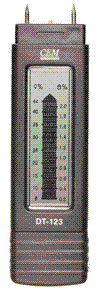
Damp Testing Meter

Relative Humidity Hygrometer
DPC Covered by External Ground
Issue: DPC Covered by External Ground
The original damp proof course added when the property was constructed could possibly be bridged or covered. A damp proof course has to be a minimum of 6 inches or 150mm above the ground.
This means in essence that on the outside of your property there maybe a section of high ground (sloping ground or a garden) or a newly built structure that is now butting up to your property e.g. a set of steps or a conservatory/outbuilding.
The object in question is most probably now bridging the gap above and below the original damp proof course and providing any damp or moisture a direct route around the damp proof course and up into the external wall.
In the majority of cases a decent, clear cavity should stop any cavity wall damp or moisture penetrating into the inside wall but in the odd instance, the moisture can travel up the wall and meet a connecting medium such as a wall tie and gain access to the inside wall.
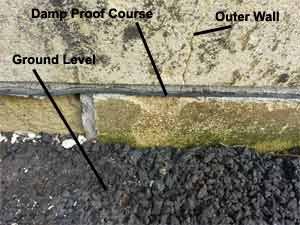
Good Example of Clear Damp Proof Course
Fix: DPC Covered by External Ground
To cure this issue you essentially have several options. The ideal fix is to clear the bridging structure e.g. dig back the garden and leave a gap between it and the external wall exposing the damp proof course, remove the sloping ground or remove the conservatory or adjoining structure.
In the case of the latter two items (conservatory or joining structure) this may not be possible, especially if you have just spent £20,000 on building the conservatory. If this is the case then this is quite a sizeable mistake on the builders part.
Where you are unable to clear the obstruction, the best and easiest fix is to add a new damp proof course by injecting a cream-based DPC solution into your walls.
There are quite a few products on the market today that enable you to DIY fix it quite quickly and easily such as Permagard or Twistfix.
To find out more about Damp Proof Injection and Damp Proof Courses in our DIY project.
Bridged Cavity or Filled with Rubbish
Issue: Bridged Cavity or Filled with Rubbish
The cavity void itself has been filled with rubbish and debris such as broken pieces of brick, mortar spillage or sand that has been dropped during the construction stage.
As we know, the main point of the cavity is to keep water and moisture away from the inner walls of a property.
Any water or moisture that penetrates the outer wall, runs down the inside of the outer wall, hits the Damp Proof Course and then runs back out.
The introduction of debris to the void then blocks the channels used by the moisture to leave and also gives it a direct route to the inner wall, creating cavity wall damp.
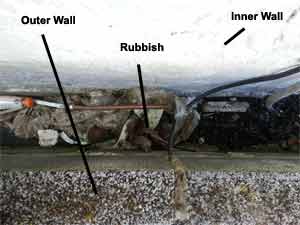
Worst Case Scenario – Poor Cavity void
Fix: Bridged Cavity or Filled with Rubbish
As you may have already guessed, the only way to fix this is to clean the cavity out.
To do this you will need to remove 1 or possibly 2 bricks at floor level or as close to floor level as possible. (NOTE: do not remove anymore than 2 bricks at a time. If you need to remove more than 2 bricks please consult with a surveyor or reliable builder).
This may sound like a bit of a daunting task but it’s quite easy (see our Replacing a Damaged Brick project for more information).
Once you have removed your brick(s) you can then use a camera or mobile phone with a light to view the cavity to establish it’s condition.
From this you should be able to see its condition and any rubbish that may be there.
You can remove the rubbish by hand (wear some sturdy gloves as there may be sharp objects in there) and where debris is out of reach, use a bar or scraping device to drag it back.
For a fine clean, use an old vacuum cleaner to suck up any smaller objects. Once done you can now replace your bricks.
Wall Ties Dirty or Corroded
Issue: Dirty or Rusty Wall Ties
Another way that damp and marks can appear on inner walls and affect the surface is due to the wall ties that are used to tie walls together.
In some situations wall ties can become dirty, normally mortar sitting on them created at the time of construction, or possibly condensation allowed to collect on them due to gaps in mortar, leaking roof, gaps around window sills etc.
This allows moisture and cold air to enter the cavity (which is technically known as Interstitial Condensation) and collect on the tie and create a "cold bridge".
This causes a difference in temperature around the affected area on the inner wall and create a cold spot.
The cold spot then allows moisture to condense much more easily than in the surrounding areas. This usually appears in the form of damp or mould.
In some cases wall ties can become rusty and corroded (again normally due to long term exposure to moisture from gaps or leaks).
The act of rusting then in most cases creates its own gap that in turn allows moisture and cold air to penetrate the cavity and produce a cold spot on the inner wall.
This type of issue can usually be easily spotted as cracks can be seen in the external mortar between the bricks or stones.
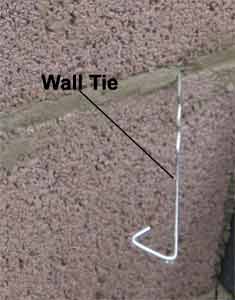
Wall Tie Positioned Between Mortar Joints in Internal Cavity Wall
Fix: Dirty or Rusty Wall Ties
Again as with the fix for a Bridged Cavity, you may have already guessed that the only way to properly diagnose and fix this issue is to remove a brick and possibly replace the wall tie itself.
Firstly using a metal detector (these can be hired from your local hire shop) locate the suspect wall tie on the outer wall, using the damp on the inner wall as a reference to the rough area.
Once the tie’s been located remove the brick that connects to the tie and inspect the condition of the wall tie. If the tie is dirty, clean it properly. If it needs replacing then see our Checking Wall Ties DIY Project.
Fixings, Wires and Pipes
Issue: Fixings, Wires and Pipes inside the Cavity Void
In some properties there can be a great deal of service fixings, bolts, screws, wires and pipes that penetrate the inner cavity wall and sit inside the cavity void itself.
This can cause cavity wall damp issues as if there is an item poking into the void from the inner cavity wall then any damp, leakage or moisture then has a direct route into the property and on to the inside wall surface.
As in some of the issues above this can create cold spots on inner walls where cold air from other gaps in the external wall (or the gap opposite if the item in question spans both walls and exits the property through the external wall) can seep through any gaps around the fixing creating a cold spot.
When this happens this can allow condensation and mould to develop or in the case of air moisture or a leak dripping on to the fixing, pipe, wire etc. itself, allow the moisture to run onto the inner cavity wall and possibly through any gaps around the fixing itself and directly onto the inside of the property.
Occasionally moisture can run down a fixing and then on down the inside wall and appear as a damp problem elsewhere on the wall so be aware of this!
It’s also worth giving your property a good going over if you are experiencing moisture or damp issues as it may be the case that it is not getting into your property exactly where you think it is and your cavity wall damp may be the sign of something much more serious such as a leaking roof!
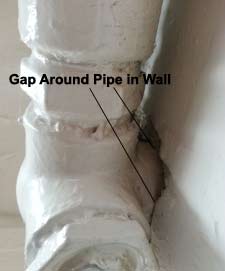
Obvious Gap Around Pipe in Internal Cavity Wall
Fix: Fixings, Wires and Pipes inside the Cavity Void
The first step is to remove the object (if possible) and properly seal up the remaining hole using the correct material, either mortar or an air tight sealing compound.
Make sure that any holes are sealed on both the inner and outer wall as you don’t want further cold air, moisture or damp to continue to access the cavity area and cause the cavity wall damp.
If it is not possible to remove the object then make sure that any gaps around it are sealed tightly.
In this instance it’s probably best to use a flexible filler, especially with heating pipes as they contract and expand depending on temperature and so a rigid filler can quickly crack and fall out creating the problem once more.
It may be also be worth moving a brick from the external wall near to where the damp or mould etc. is manifesting itself and then inspecting with a camera, mobile phone or borescope to see if you can physically see the source or the issue.
Poor Cavity Insulation
Issue: Poor Cavity Insulation Job
The issue here is really in the name – some cavity insulation companies perform sub standard work.
They will only part-fill the cavity, in some cases we have known cavities to have only been filled 400mm up from floor level as lets face it, their work is going to be hard to check, so how would you know!
One other cause is that the cavity filling holes are drilled too far apart creating gaps in the insulation and cold spots on inner walls around these gaps.
On occasion the actual cavity gap between the 2 wall skins can be narrow and does not allow much insulation to be pumped in. This can be just the way the property was built or the fact that the void was not inspected before insulating and is full of debris..
As you can see from the above there is a potential minefield of issues that can arise from a poor cavity insulation job so please, please do your research before hand and select the right type of insulation (there are quite a few on the market at present – foam, polystyrene balls, rockwool etc.) and the right installer (check their credentials, previous jobs etc.).
Beside the issues listed above and if done correctly, cavity insulation can be very effective and provide considerable savings on your heating bills.
Fix: Poor Cavity Insulation Job
Unfortunately there is no real magic cure for a poor insulation job. The only real thing that can be done is to firstly check the job and establish what the issue is (gaps, not filled correctly etc.) by removing bricks and then potentially try a re-injection of the insulation, though removal of the old insulation first may be necessary, if it is even possible.
Before you go ahead and try this always consult with a reputable and professional insulation company, again do your research first!
Fixing Cavity Wall Damp Damage on Internal Walls
In the event that your property is suffering from cavity wall damp problems these can manifest themselves as several different issues on the ground floor walls of your property giving a good indication of the potential issues that you are experiencing. Some of these issues and their potential fixes are outlined below:
Blowing Plaster and White Salts
Issue: Plaster Blowing off Walls
This issue is most commonly caused by moisture or leakage and before you attempt to fix the blown plaster you have to get the source leak sorted as if you don’t it won’t be too long before the plaster starts to blow again.
Visually, blown plaster is quite easy to spot as you can see any damp spots on wallpaper as it starts to flake off of the wall, it’s the same with paint.
With bare plaster this is also similar as you can see the plaster bulging, flaking and falling off the wall.
A common indicator is also a white salt-like substance around the affected area (efflorescence or hygroscopic salts).
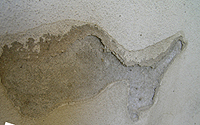
Plaster Blowing off of Wall
Fix: Plaster Blowing off Walls
Once you have fixed the leak at source and are sure that you are not going to experience any further cavity wall damp issues, leave the area to dry correctly (how long this takes will depend on the materials used, bricks, blocks, type of plaster, humidity, temperature, whether there is cavity insulation present etc.). A dehumidifier may help here.
If the plaster dries out and has not blown then you should be fine and it will not need replacing. You can then go ahead and redecorate the area.
If mould is present then you will also need to treat with an anti-fungal or mould inhibitor to ensure no mould is allowed to grow again.
In the case that you have found a white salt-like substance you will need to remove everything from the damaged area (paint, wallpaper and plaster) down to the bare wall and replaster and redecorate from scratch.
Before you do so you will need to apply a Salt Neutraliser/Inhibitor (a clear liquid used to neutralise ‘salts’ in render, plaster or masonry.
With the salt neutraliser now added (in accordance with manufacturers guidelines, allowing to dry as required) you can replaster and redecorate.
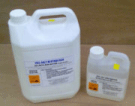
Salt Neutraliser
Damp Patches (Walls and Chimney Breast)
Issue: Damp Patches
If you have damp patches appearing at a low level around the skirting area that appear to disappear and then reappear again the chances are that this is being caused by Hygroscopic Salts.
When these salts are present they can attract moisture from out of the air and cause damp patches to appear and, as in the above Blowing Plaster issue, can cause the plaster to blow off of the wall resulting in a fair amount of cost and hassle to put it right.
If the damp is present constantly and appears higher up the wall then the most likely cause is moisture/water entering the cavity wall of the property at some other location.
Have you ever noticed a yellowy, brownish stain in the wallpaper around a chimney breast? If so then this is evidence of damp or hygroscopic chimney salt, which as in the case of salt above, is attracting moisture from the air and causing damp to appear.
As it’s around the chimney area, the act of burning coal or wood and some of the minerals found in some materials helps with the creation of the yellow and brown staining and if the damp is coming from the chimney itself then this can also contribute.
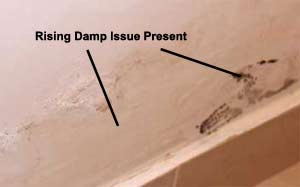
Rising Damp Evident Just Above Skirting Board
Fix: Damp Patches
If you have checked all the external walls of your property, the roof, any fixings, pipes or wires, cavity insulation issues and all are okay then the issue may be the result of Rising Damp caused by bridging of the damp proof course or it’s failure.
Establish if the DPC has been bridged and fix if you can.
If you are unable to or there is no bridging present then the introduction of a damp proof course may be required.
As commented above there are quite a few chemical DPC companies on the market offering products that can be applied quickly by the DIYer.
If the issue is not due to rising damp and the damp patches are appearing further up wall areas then you have another cavity wall damp issue.
Again, using all the information narrow down the issue and then investigate and fix. Once fixed, allow the area to dry out completely and then you can redecorate
In the event that white Hygroscopic Salts are present you will need to add a salt inhibitor to the surface before you redecorate.
If the plaster dries out okay and can be saved, add the inhibitor on top of the plaster (following manufacturers guidelines, as to whether you can add the inhibitor on top of the plaster) to prevent any further salt damage.
If the plaster cannot be saved then it will all need to be removed. Add the salt inhibitor directly on to the wall and then replaster over the top and then redecorate.
In the case of chimneys, this can be a little trickier to diagnose, as the leak may be coming from the roof (where the roof seals around the stack, cracks and damage to lead flashing), from the cavity area, from moisture or humidity inside the chimney due to a poorly capped chimney, broken stack, mortar damage to stack, broken chimney pot, poorly installed flue or liner etc. so these will need all checking out first and fixing if required.
Again, following the guidelines above, add salt inhibitor if required, replace any damaged plaster and then redecorate
In very extreme situations the salt neutraliser itself may just not be enough to cope with the amount of salts present.
In this situation you may need to apply a membrane over the wall surface (with salt neutraliser applied) before you then replaster (similar to dry lining and looks like a dimpled plastic ‘air gap’. find out more about Mesh Membrane in our lining damp walls project here.
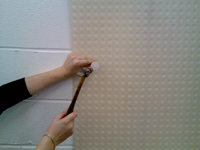
Mesh Membrane to Hold Back Salt
Damp and moisture within cavity walls can cause a multitude of issues on the inside walls of your home but to ensure any damage they cause is limited, it is essential that you find the cause and fix it. It is only then that you can successfully repair any interior wall surfaces.

